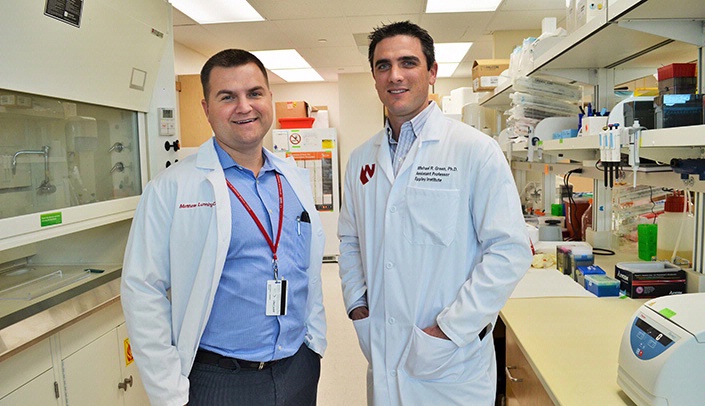When finished, the Fred & Pamela Buffett Cancer Center will be a world-class research and patient care center – not just because of the excellent facility, but also because of the world-renowned scientists and physicians who have been recruited to advance cancer care and research.
Like Michael Green, Ph.D. An assistant professor in the Eppley Institute, he began his UNMC career on the heels of a major contribution to a breakthrough in Hodgkin lymphoma treatment.
Clinical trial results for the new therapy inspired by his research were detailed in a December 2014 edition of The New England Journal of Medicine.
While a postdoc at Dana-Farber Cancer Institute in Boston in 2010, Dr. Green was first author on the discovery of a therapeutic target – a gene whose increased expression allows cancer cells to evade detection and eradication by the immune system.
Expression of this gene may be why Hodgkin relapse rates can be as high as 25 percent.
“Ligands on the tumor cell surface bind to their receptors on T-cells, blocking their normal function,” Dr. Green said. “The natural role of these molecules is to decrease the immune response after an infection has been cleared. But cancer cells hijack it so they can shut down an anti-tumor immune response.”
Thankfully, there was a potential neutralizing antibody already in clinical trials. So a study involving patients with relapsed or refractory lymphoma got to skip straight to Phase II, to “a pretty remarkable result,” Dr. Green said. The treatment was awarded breakthrough therapy designation by the FDA. By the time the clinical trial started in 2011, Dr. Green already had left for Stanford University, but still feels very satisfied with the end result.
“That’s why we do what we do,” he said. “Publications and grants are nice, but this is the real reason behind our research.” At Stanford, Dr. Green turned his attention to the as-yet incurable follicular lymphoma. And there is no better place to continue this research, he decided, than at UNMC, where Jim Armitage, M.D., and Julie Vose, M.D., head up a world-renowned lymphoma study group.
“That was imperative in coming here,” he said. “Laboratory research is only as good as the difference that it makes to patients.
Here we have a superb clinical team, so we can effectively translate research from the laboratory to the clinic in the form of new treatment strategies, and we also can use laboratory research to
understand the diverse outcomes with current treatments.”
Also helpful is the relationship history of the patients who donated tumor tissue.
Now, Dr. Green is studying a novel gene mutation that helps follicular lymphoma cells evade the immune system. “We have defined the mutation we want to target, so now we are trying to identify a specific therapy – it is a great example of ‘precision medicine.'”
A new recruit collaboration
Dr. Green has teamed with Matthew Lunning, D.O., a fellow new recruit to the Fred & Pamela Buffett Cancer Center.
Together, they formed the Lymphoma Precision Medicine Laboratory, a multi-disciplinary lab with both a clinical and research focus. It operates as part of the Dr. James O. Armitage Center for Leukemia and Lymphoma Research.
“Our goal is to apply molecular laboratory research to better understand and target therapies in lymphoma,” Dr. Green said. “As part of this effort, we are performing scientific correlates along with clinical trials to identify biomarkers that can be used in the future to target the next generation of lymphoma therapies specifically toward patients who are most likely to benefit.”
Drs. Green and Lunning also are attempting to re-evaluate the approach used for lymphoma classification – so as to better classify patients into groups more likely to respond to similar therapies. To do so, they’ll incorporate information from genetic alterations that directly drive the disease. Patients with similar genetic alterations will be grouped together.
They’ll take advantage of the Nebraska Lymphoma Study Group’s tissue bank: “It has thousands of tumors that we can evaluate for genetic mutations and identify groups with similar genetics and clinical behavior,” Dr. Green said. “The aim is to pave the way for future therapeutics to be developed for these genetic subtypes that specifically address the etiology of the disease, so that patients can be treated using a ‘precision medicine’ approach based upon their individual tumor’s molecular characteristics.”
It’s collaborations like this at UNMC that allow innovation to happen.
Web extras
Watch a CBS News report on the breakthrough Hodgkin’s lymphoma treatment.
Read about the clinical trial.
Read Dr. Green’s research article on a new therapy target.
Learn more about UNMC’s core facilities.
Read Dr. Green’s journal article on follicular lymphoma.
